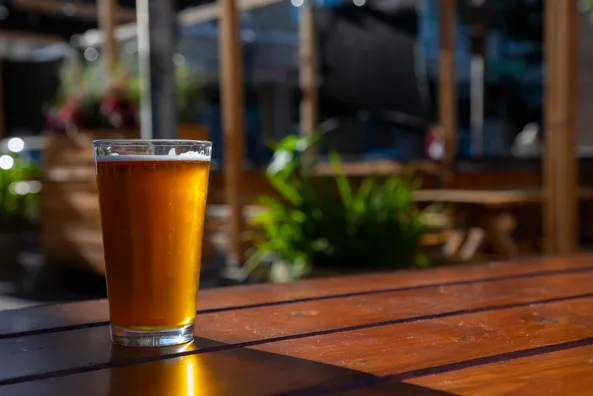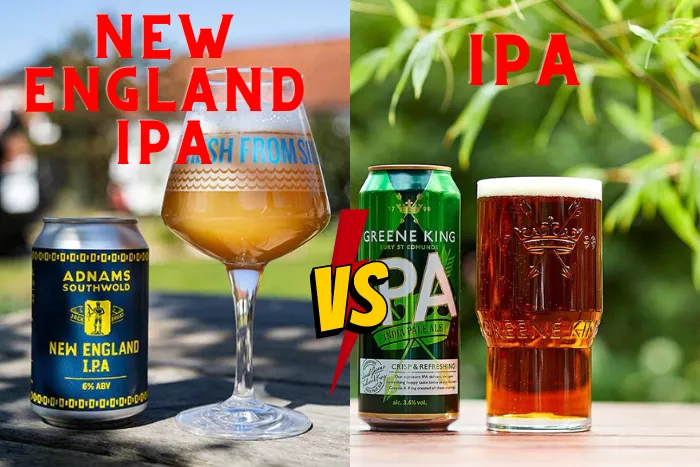Are you curious about the differences between New England IPA and regular IPA? From their origins to their flavor profiles, there is a world of difference between these two beer styles. This blog post compares New England IPA and IPA ingredients, fermentation and brewing process, color, alcohol content, and IBU levels. Plus, we’ve got a list of popular beers for each style that our readers should try. So read on to find out more about New England IPA vs IPA.
Table of Contents:
- Origins and History of New England IPA vs IPA
- Ingredients Used in New England IPA vs IPA
- Fermentation and Brewing Process for New England IPA vs IPA
- Flavor Profile and Mouthfeel of New England IPA vs IPA
- Color, Alcohol Content, IBU, and Health Impact of New England IPA vs IPA
- FAQs about New England Ipa vs Ipa
- Conclusion
History of New England IPA

The beginnings of New England IPA can be traced to the early 2000s when brewers in Vermont started exploring different hops and brewing processes. The style was created to highlight the region’s terroir and hop flavors. These IPAs have become known for their juicy, fruity aromas and hazy appearance.
History of IPA
IPA (India Pale Ale) has roots in British brewing culture from the late 1700s. It was originally brewed as an export beer meant to survive long sea voyages from Britain to India without spoiling. Due to filtration or pasteurization, this style is clear and has a strong hop bitterness and malty sweetness.
New England IPA vs IPA
New England IPAs have gained significant traction in recent years, their intense flavor profiles featuring tropical fruits such as pineapple, mango, and citrus along with low bitterness levels compared to other hoppy beers like West Coast IPAs or Double/Triple IPAs winning over craft beer drinkers.
Unfiltered and unpasteurized, these hazy brews are more opaque than classic versions. Therefore, while IPA remains popular among beer aficionados, these juicier New England variants seem to be taking the lead.
Ingredients Used in New England IPA
New England IPAs are brewed with malted barley, wheat, and oats. These grains provide the beer with its hazy appearance and smooth mouthfeel. They also give it a unique flavor profile that is distinct from other styles of IPA. Citra, Mosaic, Amarillo, Simcoe, and Centennial hops give this style a fruity aroma and flavor. These hops contribute to the juicy aroma and flavor of these beers.
Ingredients Used in IPA
IPAs of the traditional variety is brewed with pale malt as a base grain and crystal malt for color and body. Floral or herbal hops, such as Cascade, Chinook, Columbus/Tomahawk/Zeus (CTZ), Warrior, and Nugget, are used for bittering additions. In contrast, late hop additions can vary depending on the brewer’s preference. Brewers can combine the various components to make a flavorful and harmonious IPA.
On the contrary, traditional IPA brewers may add spices like coriander or orange peel at flameout before cooling wort down to add subtle but noticeable flavors.
The blend of components found in New England IPAs and IPAs can have a noteworthy effect on the flavor, aroma, and general taste. Moving on to each style’s fermentation and brewing process, let’s explore how these processes affect their distinct characteristics.
Fermentation and Brewing Process for New England IPA vs IPA

New England IPA Fermentation Process
Fermenting New England IPAs is typically done at lower temperatures for a prolonged period. This beer style is usually fermented at temperatures between 60 to 70 degrees Fahrenheit, potentially lasting up to two weeks or longer depending on the yeast strain used, allowing for sugar breakdown into alcohol and carbon dioxide that gives a smooth mouthfeel and fruity flavor profile.
During this time, the yeast will break down sugars into alcohol and carbon dioxide, producing a beer with a smooth mouthfeel and fruity flavor profile. To enhance these characteristics, some brewers also add fruit purees or juices during fermentation.
IPA Fermentation Process
In contrast to New England IPAs, traditional India Pale Ales are typically fermented at higher temperatures to create more hop bitterness and stronger flavors from malt extractions. Generally speaking, an IPA’s fermentation temperature ranges between 68 to 72 degrees Fahrenheit, producing higher esters (fruity aromas) than those found in NEIPAs due to their warmer fermentations.
Additionally, many IPA recipes call for dry hopping – adding hops late in the brewing process – which adds additional aroma complexity without imparting any extra bitterness.
Flavor Profile of New England IPA
A smooth, creamy mouthfeel with juicy and tropical fruit notes generally characterizes New England IPAs. This style typically has lower bitterness levels than traditional IPAs, allowing hop aromas to shine without being overly bitter. Additionally, the yeast used in this style often contributes additional flavors, such as banana or clove. The malt bill for these beers is usually lighter in color and more subdued than other IPA styles, allowing the hops to take center stage.
Flavor Profile of IPA
In contrast, IPAs have a bolder flavor profile emphasizing hoppy bitterness over sweetness. Brewing with a selection of hop varieties can bring about piney, citrusy, floral, or herbal aromas and tastes. The malt bill tends to be slightly darker than those found in New England IPAs and provides an added layer of complexity that helps balance out the hop character while still allowing it to stand out prominently on your palate.
Regarding mouthfeel differences between these two beer styles, there are some notable distinctions worth noting. Due to its higher level of carbonation compared to New England IPAs, traditional IPAs tend to have a drier finish that can linger on your tongue after you take a sip. On the other hand, New England IPAs have less carbonation resulting in a much creamier texture that coats your entire mouth upon drinking it – think velvet instead of sandpaper.
Furthermore, their low bitterness levels mean they don’t leave any astringent aftertastes behind as their counterparts do; making them easy-drinking options for even novice craft beer drinkers who may not enjoy hoppier brews yet.
Color, Alcohol Content, IBU, and Health Impact of New England IPA vs IPA
Regarding hue, New England IPAs and regular IPAs differ greatly. New England IPAs are typically hazy or cloudy in appearance due to their higher protein content from wheat, oats, and other grains used during the brewing process.
These beers also tend to have a softer yellow hue, with some slightly orange-tinged. Traditional IPAs are clear or lightly hazy and range from light straw yellow to deep copper.
Alcohol Content in Both IPAs
The alcohol content is another area where these two styles vary significantly. Generally, NEIPAs contain a lower ABV than regular IPAs; usually between 4% and 6%, whereas traditional IPAs may range from 5-10%. This makes them easier on your palate and wallet since you can enjoy more without feeling overly intoxicated.
IBU in Both IPAs
The International Bitterness Unit (IBU) scale measures bitterness in beer based on hop additions during brewing; this number ranges from 0-100 depending on how many hops were added. Most NEIPAs have less than 30 IBUs, making them smooth but hoppy.
Health Benefits of New England IPAs and IPAs
When it comes to health benefits, both styles of beer have something to offer. Regular IPAs contain antioxidants that help fight off free radicals that cause cell damage over time. NEIPAs are typically lower in calories than their counterpart, making them ideal for those looking for healthier options when it comes time to imbibe.
FAQs about New England Ipa vs Ipa
What is the difference between an IPA and a New England IPA?
IPAs (India Pale Ales) are beers characterized by high hop bitterness, strong aroma and flavor, and relatively higher alcohol content. On the other hand, New England IPAs (NEIPA) is an emerging style of IPA with distinct characteristics from traditional IPAs.
Due to their lower carbonation and higher oat content, NEIPAs have a softer mouthfeel. They typically feature more fruity or tropical flavors than bitter hoppy notes in regular IPAs. Finally, NEIPAs are less bitter than traditional IPAs because their yeast reduces the harshness of dry hopping hops.
What’s the difference between West Coast IPA and Northeast IPA?
Strong hop bitterness and an intense citrus, piney, and resinous aroma characterize West Coast IPA. It typically has a golden to copper color with medium maltiness. Northeast IPAs are known for their juicy character and hazy appearance.
They have lower hop bitterness than West Coast IPAs but still contain strong hop flavor and aroma levels. They also tend to be sweeter due to adding oats or wheat in brewing, which can lead to a fuller body than West Coast IPAs.
What is the difference between West Coast and New England IPAs?
West Coast IPAs are typically more bitter and have a higher alcohol content than New England IPAs. West Coast IPAs generally have more of a bitter, citrusy, or pine-like smell. In contrast, New England IPAs often taste sweeter and are creamier with hints of tropical fruits such as mangoes and pineapples.
West Coast IPAs also tend to be clearer in color due to the dry-hopping process used during brewing, whereas New England IPAs can appear hazy from adding oats or wheat malt during fermentation.
Is NEIPA the same as Hazy IPA?
NEIPA (New England India Pale Ale) and Hazy IPA differ. While both beer styles have a hazy appearance due to their high levels of proteins and yeast, NEIPA is generally brewed with more wheat or oats than other IPAs, giving it a smoother mouthfeel and fuller body. Additionally, NEIPA tends to be less bitter than traditional IPAs and has higher fruity esters, such as pineapple or mango flavors, that aren’t found in Hazy IPAs.
Conclusion
In conclusion, New England IPA and IPA beers have distinct differences in origins, history, ingredients used, fermentation and brewing process, flavor profile and mouthfeel, and color. Furthermore, their alcohol content IBU levels and health impacts are also different. Thus, it is essential to understand these differences to ensure you can make an informed decision about the type of beer best suited to your preferences.
Join us to explore the world of beer! From reviews on New England IPAs and IPAs to advice on brewing equipment and subscription services, our blog is your source for all things related to craft beer.

